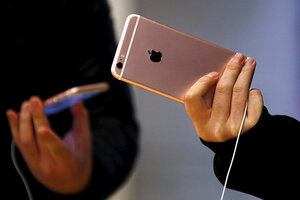Apple faces up to $862 million in fines for patent infringement
A jury has voted in favor of the University of Wisconsin-Madison, which claims that the most recent iPhones and iPads unlawfully use its patented chip technology that makes processors more efficient.

Customers hold the iPhone 6s during the official launch at the Apple store in central Sydney, Australia, September 25, 2015.
David Gray
Apple might be guilty of patent infringement, a federal jury in Madison, Wisconsin, found Tuesday.
The iPhone company faces up to $862 million in damages for using processor technology owned by the licensing arm of the University of Wisconsin-Madison.
The Wisconsin Alumni Research Foundation (WARF) sued the $200 billion tech company in early 2014 alleging violation of its 1998 patent on improving chip efficiency, which the university says was used in the most recent iPhones and iPads.
US District Judge William Conley presided over the case and scheduled three phases for the trial – liability, damages, and a determination as to whether the Apple’s infringement was willful.
The jury has yet to finalize the exact amount due in damages and if it finds that Apple had infringed the patent willfully, even harsher penalties may be introduced.
“I wouldn’t be surprised if the plaintiff made an aggressive push for willfulness enhancements,” Florian Mueller, an expert in patent infringement lawsuits, tells Forbes magazine. If that were the case, he says, the damages could triple. “But in the past, damages awards of this proportion have typically been reduced on appeal.”
Apple argued that the patent isn’t valid and has attempted to appeal to the US Patent and Trademark Office about its credibility, to no avail. The company refutes the notion that it’s guilty of any infringement by questioning the patent’s validity, but the jury disagreed. According to the jury verdict, WARF had sufficiently proved that Apple had infringed the patent on six different claims.
US Patent No. 5,781,752 was filed by WARF to protect a “table based data speculation circuit for parallel processing computer.”
“A predictor circuit permits advanced execution of instructions depending for their data on previous instructions by predicting such dependencies based on previous mis-speculations detected at the final stages of processing,” the official patent filing explains. “Synchronization of dependent instructions is provided by a table creating entries for each instance of potential dependency. Table entries are created and deleted dynamically to limit total memory requirements.”
Under the same patent, WARF sued Intel in 2008, but the lawsuit settled before going to trial. The settlement totaled $110 million in a lump sum.
Apple is no stranger to litigation. A docket search pulls up more than 500 civil cases in which the company is involved. Under patent law alone, Apple has been involved in more than a handful of high-profile lawsuits. For instance, its battle with Samsung stretched across the globe in multiple cities and has been ongoing for more than four years.
According to a national legal database, Apple’s most recent legal complaint was filed by a Delaware company alleging that its patent for a location tracking method system was violated by the tech giant.

